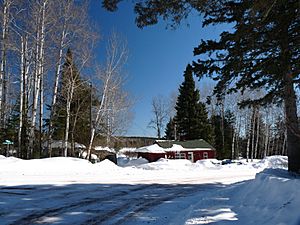Morse (community), Wisconsin facts for kids
Quick facts for kids
Morse, Wisconsin
|
|
|---|---|
 |
|
| Country | |
| State | |
| County | Ashland |
| Town | Gordon |
| Elevation | 466 m (1,529 ft) |
| Time zone | UTC-6 (Central (CST)) |
| • Summer (DST) | UTC-5 (CDT) |
| Area code(s) | 715 & 534 |
| GNIS feature ID | 1579920 |
Morse is a small, unincorporated community in Ashland County, Wisconsin, United States. An "unincorporated community" means it's a group of homes and businesses that isn't officially a city or town with its own local government. Morse is located in the town of Gordon. It sits along the Bad River, about 7.5 miles (12 km) south-southeast of Mellen.
Contents
History of Morse
Morse has a rich history tied to the lumber industry in Wisconsin. It started as a busy mill town.
Building a Mill Town
In 1881, a new company called the Bad River Lumbering and Improvement Company began building a town. They chose a spot where the Wisconsin Central Railroad met the Bad River. This new town was first called Jacob's Station. It was named after William H. Jacobs, who led the Bad River Company.
At the same time, the company improved a part of the Bad River. This was so they could float logs from their forests upstream down to the mill. This process is called log driving. By the spring of 1882, the company had built many important structures. These included a sawmill, a mill for making shingles (thin pieces of wood for roofs) and lath (thin strips of wood), a boarding house (a place for workers to live), a store, a blacksmith shop, and sheds for storing lumber.
Early Operations and Growth
The sawmill started cutting wood in June 1882. That winter, the company ran three logging camps in the nearby forests. By 1884, the mill was very busy. It employed 50 to 75 men and shipped out as many as five train cars full of lumber every day. The town also grew, adding a hotel called the Bad River House. In 1887, a schoolhouse was built for the children living in Morse.
The Penokee Lumber Company Era
In 1887, the Penokee Lumber Company bought the town and its businesses. This company was owned by investors from New York and a man named Augustus W. Morse. Augustus Morse, who was from Saginaw, Michigan, became the local manager. Under his leadership, the mill got many upgrades. They improved the machinery, reorganized the plant, and even added electricity. A planing mill, which smoothed and shaped lumber, was also added.
To prevent fires, which were a big danger in lumber mills, wood scraps were cleaned up daily. Large barrels of water were kept ready in case of a fire. The mill also had about 70 Clydesdale horses in its stables. These strong horses helped with moving logs and other heavy tasks. The Northwestern Lumberman journal, a newspaper about the lumber industry, even called it a "model mill."
In 1889, the town's name was officially changed to Morse, honoring Augustus W. Morse. Most of the lumber produced here was sent by train to places like Omaha in the west. It also went east to Tonawanda, New York, by train to Ashland and then by ships on the Great Lakes. About 275 men worked for the company, and it provided twenty houses for its employees. All the buildings, including the homes, were painted a special "Morse red" color.
Challenges and Changes
In 1890, Penokee Lumber made a big deal to ship 3,000,000 feet of lumber to England. However, in 1891, there was a very dry year. The rivers became too low for log driving, so the mill ran out of logs and had to close for a while in the fall. In 1892, millworkers in other areas went on strike to get a shorter workday. The workers in Morse did not strike, but the Penokee Lumber Company decided to adopt the ten-hour workday anyway. By 1895, about 600 people lived in Morse. Soon after, the Penokee Lumber Company closed down. This might have happened because they ran out of timber, or it could have been due to a financial crisis called the Panic of 1893.
Later Years and Today
In 1900, F. B. Chase from Oshkosh bought the town and nearby timber. He started logging and milling again. But in 1903, a fire destroyed the sawmill. After this, many people moved away from Morse.
In 1917, the Kneeland-McClurg Lumber Company began using Morse as a place to prepare logs for shipping to their sawmill in Phillips. Later, they rebuilt a sawmill in Morse. They also built homes and a boarding house for the millworkers. The population grew again, and the town had to make the school bigger. After Kneeland-McClurg left in the early 1930s, manufacturing in Morse became less regular.
In the early 1940s, the Templetons used the old mill's kilns (special ovens for drying wood) to make cedar shingles. In 1946, Cohen and Carlson started making hampers (baskets) and ladders. Today, only a few buildings remain in Morse, showing its past as a busy lumber town.



